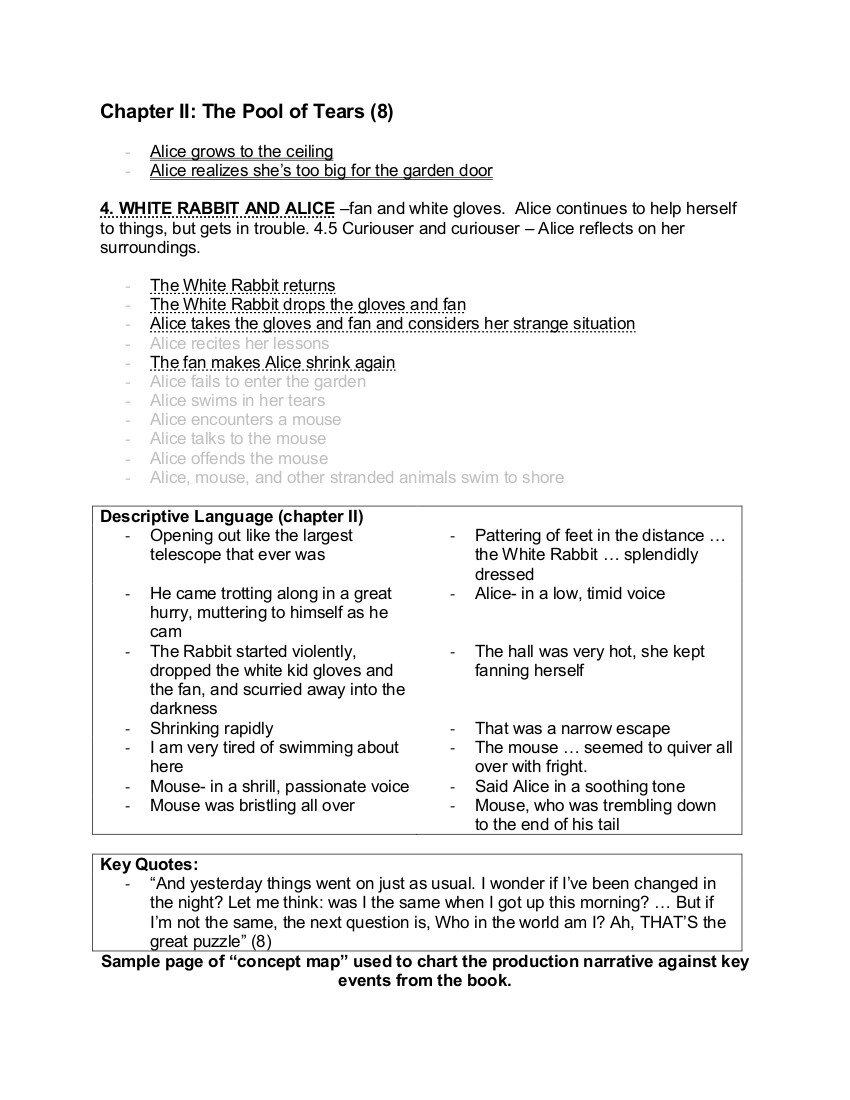
“And yesterday things went on just as usual. I wonder if I’ve been changed in the night? Let me think: was i the same when I got up this morning? … But if I’m not the same, the next question is, Who in the world am I? Ah, that’s the great puzzle.”
Alice, Alice’s Adventures in Wonderland

Alice learns from the White Queen

Fall of the Red Queen

The croquet game

The tea party

Alice goes down the rabbit hole

Dramaturgy display

A sample page of my dramaturgy "concept map" to aid in choreography, composing, and character work.
Wonderland: Alice’s Adventures in Three-Dimensional Space
Director/Choreographer: Margaret Wilson
Rigging Master: Neil Humphrey
Scenic Design: Scott Tedmon-Jones
Costume Design: Scott Tedmon-Jones/The Company
Projection & Lighting Design: Jason Banks
Composer & Lyricist: Seán Warren Stone
Dramaturgy & Acting Coach: Patrick Konesko
Production Stage Manager: Bri Leonard
Photography: University of Wyoming Institutional Marketing
Approach:
Wonderland: Alice’s Adventures in Three-Dimensional Space was a collaborative, year-long project to create a vertical dance adaptation of both Alice’s Adventures in Wonderland and Through the Looking-Glass and What Alice Found There. Early on, I was asked to join team as both dramaturg and acting coach. The goal of this project was not just to explore these stories in a novel way, but also to put the focus on Alice’s journey, growth, and ever-growing sense of self determination. We also hoped to use vertical dance as a way of contributing to the text’s investment in whimsy as well as a tool to help us defy gravity, and audience expectations.
As dramaturg, my job was to help conceptualize and implement the selected narrative episodes, to help contextualize those episodes in regards to the original books, to attend rehearsals to provide support for the director/choreographer, and to conduct supplemental research on Carroll, the books, relevant history, and other dance-based productions of the Alice story. I also worked with the design team and the University of Wyoming Shell 3D Visualization Center to assist in the creation of an immersive/interactive 3D experience for patrons in the lobby and created my own, more traditional, dramaturgy display (pictured above) that mirrored design elements from the production, explained some of the choices we made in conceptualizing the production, and included another multimedia element in the form of a tablet playing eight minutes of the 1903 silent film version of the story. My most significant dramaturgical contribution to this project was the creation of a comprehensive “concept map” of the production. This document (example page pictured above) was meant to aid in choreography, music composition, and helping the dancers create their characters, by contextualizing each of our selected/adapted scenes within Lewis Carroll’s text. For each chapter of the books, I charted basic “action units,” mined descriptive language to aid in conceptualizing design choices, and included key quotes. Then, I placed each of our selected scenes into the document in its corresponding chapter and highlighted all of the corresponding action units (while graying out the ones that we chose not to focus on for future reference). I created this document to help us keep track of the complicated story line, while also offering quick reference and descriptive language for the purposes of inspiring design and choreography choices.
As acting coach, my job was to help dancers, who might not otherwise be versed in representational acting, rise to the challenge of embodying the iconic characters of the Alice stories. These responsibilities began in auditions, where I gave acting-style direction to performers and helped evaluate the range of each dancer in regards to characterization. After auditions, I attended rehearsals regularly to lead acting exercises, talk about acting theory, and give notes to both principal characters and chorus. In this capacity I also helped shape scenes to match the emotional and thematic structure established during the initial conceptualization of the project.